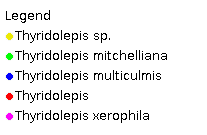Thyridolepis Contr. Queensland Herb. 13: 25 (1972).
Derivation:. From Greek thyris (genitive thyridos) (window) and lepis (scale), alluding to the translucent scales.
Taxonomic revisions, nomenclatural references:. S.T. Blake, Contr. Queensland Herb. 13: 25 (1972).
Key references (keys and floras):. M.Lazarides, Flora of Central Australia 485–486 (1981); J.C.Tothill and J.B.Hacker, Grasses of Southern Queensland 408–409 (1983); J.P.Jessop, Flora of South Australia 4: 1983–1984 (1986); B.K.Simon, Key to Australian Grasses 169 (1993); D.Sharp and B.K.Simon, AusGrass (2002); J.P.Jessop, Grasses of South Australia 504–506 (2006); S.W.L.Jacobs, R.D.B.Whalley & D.J.B.Wheeler, Grasses of New South Wales, 4th ed, 385–386 (2008).
W.D.Clayton & S.A.Renvoize, Genera Graminum (1986), genus (447).
Native, endemic. 3 species, from arid mainland Australia. WA, NT, SA, Qld, and NSW.
Habit. Perennial (with basal scaly, woolly cataphylls), tufted or decumbent. Culms woody and persistent, or herbaceous. Leaf blades narrow. Ligule a fringe of hairs.
Inflorescence. Inflorescence a single raceme (spikelike, bristly), a single raceme or spike.
Spikelets. Spikelets dorsally compressed, 2 flowered, with 1 fertile floret, solitary, shortly pedicelled. Fertile spikelets with lower incomplete floret(s), oblong or elliptic or lanceolate, abaxial (with lower glume on side away from rachis), falling with glumes.
Glumes. Glumes more or less equal, long relative to adjacent lemmas, hairy, awnless, non-keeled, dissimilar (both leathery, the lower blunt, with a transverse row of tubercle-based bristles along the top of a rectangular, semi-transparent or pigmented `window', the upper broader, rostrate, with tufts of tubercle-based bristles along the margins). Lower glume 7–11 nerved. Upper glume 7–11 nerved.
Florets. Lower incomplete floret(s) male, or sterile. Lemmas awnless, 5 nerved, more or less equalling fertile lemmas, becoming indurated (not gibbous). Fertile florets 1. Lemmas similar in texture to glumes, not becoming indurated, brown in fruit, entire at apex, pointed, muticous, with a clear germination flap, 3–5 nerved, glabrous, having flat margins not tucked into palea. Palea relatively long, entire, textured like lemma, 2 nerved. Lodicules when present 2. Stamens 3. Grain small, compressed dorsiventrally. Hilum short. Embryo large.
Kranz Anatomy. C3.
2n = 18 and 36, 2 and 4 ploid.
Habitat. Xerophytic. Dry grassland and scrub. Species of open habitats.
Classification. Panicoideae; Neurachneae.
Notes. Neurachne, Paraneurachne and Thyridolepis are traditionally placed in an endemic Australian tribe the Neurachneae (Blake, 1972). However recent cladistic work on morphological characters (Zuolaga, Morrone and Giussani, 2000) reveal that Neuracheae is not monopyletic, and the three genera are placed widely among the Paniceae (B.K.Simon).
Types Species. T. mitchelliana (Nees) S.T.Blake.
Biogeographic Element. Clifford & Simon 1981, Simon & Jacobs 1990: Endemic.


